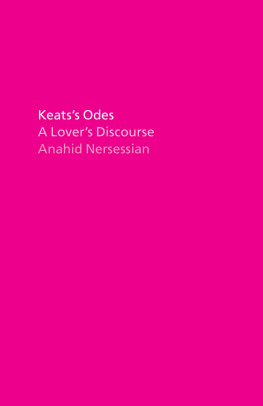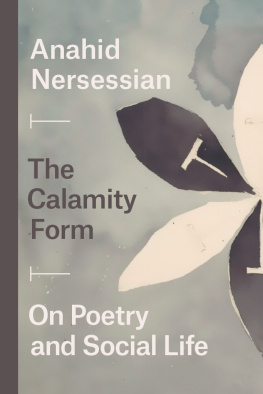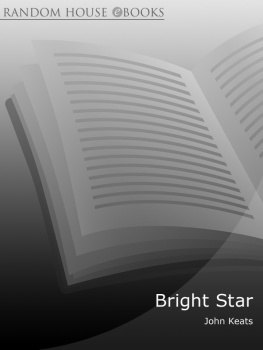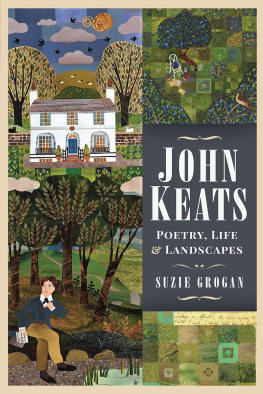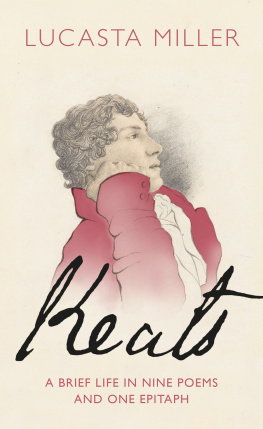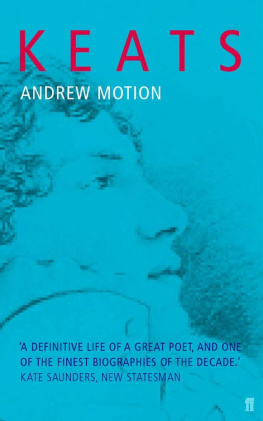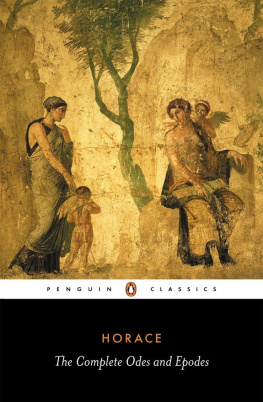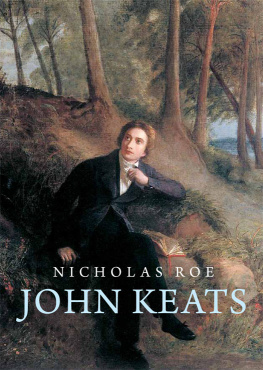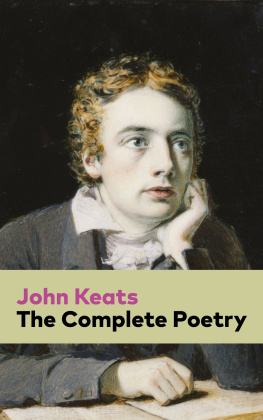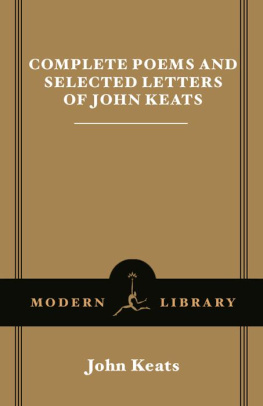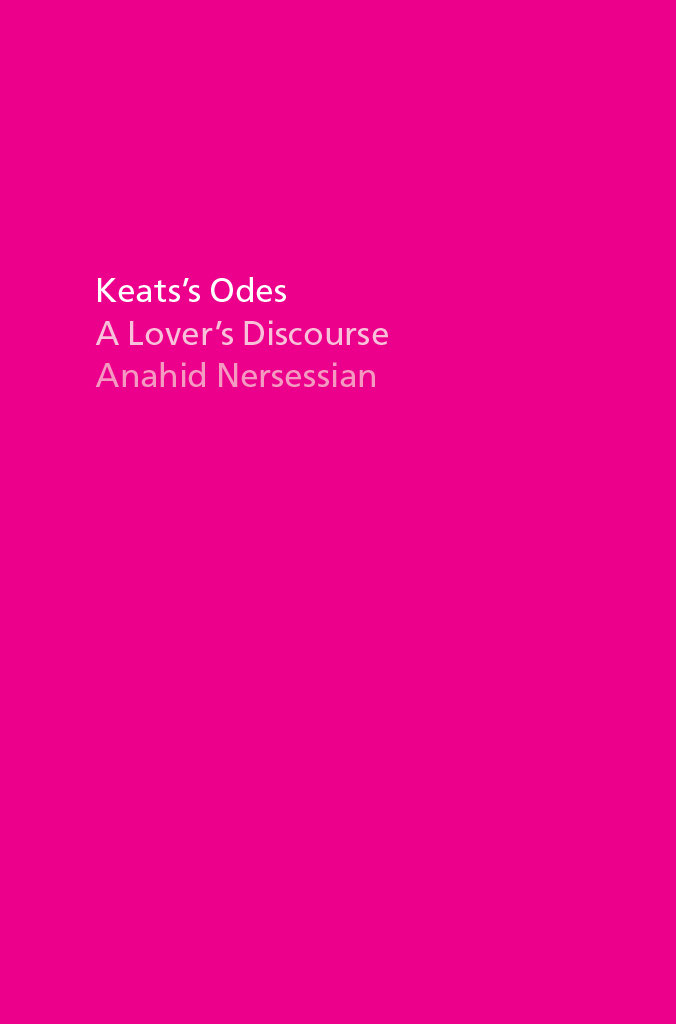Keatss Odes
Keatss Odes
A Lovers Discourse
Anahid Nersessian
The University of Chicago Press Chicago and London
The University of Chicago Press, Chicago 60637
The University of Chicago Press, Ltd., London
2021 by The University of Chicago
All rights reserved. No part of this book may be used or reproduced in any manner whatsoever without written permission, except in the case of brief quotations in critical articles and reviews. For more information, contact the University of Chicago Press, 1427 East 60th Street, Chicago, IL 60637.
Published 2021
Printed in the United States of America
30 29 28 27 26 25 24 23 22 21 1 2 3 4 5
ISBN-13: 978-0-226-76267-8 (cloth)
ISBN-13: 978-0-226-76270-8 (e-book)
DOI: https://doi.org/10.7208/chicago/9780226762708.001.0001
Library of Congress Cataloging-in-Publication Data
Names: Nersessian, Anahid, 1982 author.
Title: Keatss odes : a lovers discourse / Anahid Nersessian.
Description: Chicago ; London : The University of Chicago Press, 2021. | Includes bibliographical references and index.
Identifiers: LCCN 2020028776 | ISBN 9780226762678 (cloth) | ISBN 9780226762708 (ebook)
Subjects: LCSH: Keats, John, 17951821Criticism and interpretation. | English poetry19th centuryHistory and criticism.
Classification: LCC PR4837 .N37 2021 | DDC 821/.7dc23
LC record available at https://lccn.loc.gov/2020028776
This paper meets the requirements of ANSI/NISO Z39.48-1992 (Permanence of Paper).
For Tatianna, who told me to write it
Contents
The heart uselessly opens
To 3 words, which is too little
George Oppen
If youve never read anything on Keatss odes before, this book should not be your first stop. It is a collection of essays based on intimate, often idiosyncratic responses to the poems. In fact it is probably better to call them meditations instead of essays. The literary critics whove taught me the most about Keats are rarely if ever cited in what follows, as this is a book designed for non-specialists. For those who would like to read further, I recommend starting with Walter Jackson Bate, The Stylistic Development of Keats; James Chandler, chapter 7 of England in 1819: The Politics of Literary Culture and the Case of Romantic Historicism; Paul H. Fry, History, Existence, and To Autumn; Marjorie Levinson, Keatss Life of Allegory; Jerome J. McGann, The Romantic Ideology: A Critical Investigation; Christopher Ricks, Keats and Embarrassment: Nicholas Roe, John Keats and the Culture of Dissent, plus Roes excellent biography; Helen Vendler, The Odes of John Keats; and Susan Wolfson, Formal Charges: The Shaping of Poetry in British Romanticism along with various essays.
While I was writing, Jonathan Kramnick pointed me toward Dorothy Van Ghents unfinished Keats: The Myth of the Hero, edited and revised by Jeffrey Cane Robinson. It is out of print but well worth tracking down. The best biography is probably Bates John Keats, but Aileen Wards John Keats: The Making of the Poet is my favorite. As the book makes clear, I think any serious appreciation of Keatss poetry begins with the section on Private Property and Communism from Karl Marxs Economic and Philosophical Manuscripts of 1844 and the first volume of Capital, too.
John Keats was born on October 31, 1795, and he died of tuberculosis on February 23, 1821, aged twenty-five. In that narrow patch of existence he composed some of the most unrepentingly alive poems in the English language. It is possible that, had he survived, he would have written no more; quitting had always been an option, and he needed real money to support himself and his fiance, Fanny Brawne. It is also possible that he would have kept writing, and possible too that he would have burrowed even deeper into the broken heart of his century, which, he knew, was reordering time and space in answer to the demands of a new and rapacious economic system. George Bernard Shaw saw in Keats the makings of a full-blooded modern revolutionist, and if he didnt reach the barricades he did belong on them, because there was nothing Keats loved more than us: those who know this is not all we are meant to be. His poetry is a record of that love and its wild, inconvenient expression. It is a lovers discourse, at once compassionate, exacting, indecent, and pure.
This book collects six of Keatss poems, known together as the Great Odes. I follow each ode with a short essay that is both critical and autobiographical, although the autobiographical dimension will not always be obvious. In that sense, the essays work like the odes. Odes, roughly speaking, are poems meant to celebrate something or someone, but because they are written from a place of emotional excess or ferment its easy for them to tip over into more private preoccupations: thus Percy Bysshe Shelleys Ode to the West Wind, which connects the cycle of the seasons to the here today, gone tomorrow movement of revolutionary struggle, also erupts into the furiously personal cri de coeur I fall upon the thorns of lifeI bleed! In writing about Keatss odes, I have tried to prop myself open to this same uneven traffic of literary and intimate concerns. This book, then, is a love story: between me and Keats, and not just Keats.
Keats himself was famously lovable, despite having been born (he said) into an unpromising morning. That sense of bleakness, of having failed before he had begun, dogged him. He was poor. He was short, six inches below average, and in ill health. Once he began publishing his work was almost universally panned. He was temperamental, obsessive, and thin-skinned, and his childhood, which was traumatic, left him nervous, morbid, in the words of his brother George. All the same, he amassed a small army of devoted friends, one of whom called him the most lovable associate... that ever lived in the tide of times. Of his death, or perhaps their relationship, Brawne wrote, I have not got over it, and never shall.
When I say this book is a love story, I mean it is about things that cannot be gotten overlike this world, and some of the people in it.
*
The word that gets used most often in conjunction with Keats is sensuous. He is fascinated by how things feel, and by the capacity of metaphor to register the dizzying strangeness of being a body among others. Only Keats could come up with the thrilling liquidity of dewy piping or a breathless honey-feel of bliss, and not always to his credit. The early poetry, like the soupy epic Endymion, expels an unfortunate phrase every couple of lines: well-wooing sun, night-swollen mushrooms, fire-tailed exhalations, and so on. This kind of writing disgusted contemporary reviewers, who called it puerile and effeminate, unhealthy and unclean; In Wordsworth, one sniffed, there is no such unhealthy lusciousness. Lord Byron agreed: Such poetry, he declared, is a sort of mental masturbation, and elsewhere he snickers about Johnny Keatss piss-a-bed-poetry. A century later William Butler Yeats slides into the same vein:
I see a schoolboy when I think of him
With face and nose pressed to a sweet-shop window,
For certainly he sank into his grave
His senses and his heart unsatisfied,
And madebeing poor, ailing and ignorant,
Shut out from all the luxury of the world,
The coarse-bred son of a livery stable-keeper
Luxuriant song.
Yeats makes explicit what Byron doesnt have to: not only is Keatss poetry sexually deviant, its indecency (or luxuriance) is amplified by his lower-middle-class status. The Romantic period had a taste for so-called peasant poets like Stephen Duck, Ann Yearsley, and John Clare, but Keats was not a peasant. Worse, he skimmed the proletarian perimeter while being aspirationally shabby-genteel, a fanciful dreaming tea-drinker with a false claim on respectability. In the alchemy of nineteenth-century social prejudice, this rendered him at once oversexed and insufficiently masculine. He was an outcast and a striver and out of genital control, fggg his Imagination (Byron again) instead of a nice warm body. Its a singularly nasty assessment, and it sticks.
Next page
